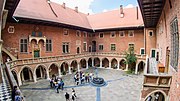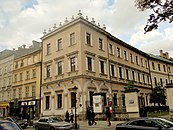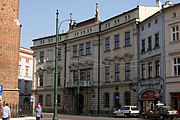Jagiellonian University
Uniwersytet Jagielloński | |
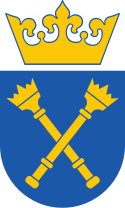 | |
| Latin: Universitas Iagellonica Cracoviensis | |
Former names | University of Kraków (1364–1817) |
|---|---|
| Motto | Plus ratio quam vis |
Motto in English | Let reason prevail over force |
| Type | Public |
| Established | 1364 (660 years ago) |
| Rector | Wojciech Nowak [pl] |
Academic staff | 3,857 (2017)[1] |
| Students | 43,405 (2017)[1] |
| Undergraduates | 38,535 (2017) |
| Postgraduates | 1,655 (2017) |
| 3,215 (2017) | |
| Location | , 50°3′39″N 19°55′58″E / 50.06083°N 19.93278°E |
| Campus | Urban/College town |
| Affiliations | EUA, Coimbra Group, Europaeum, Utrecht Network, EAIE, IRUN, Guild of European Research-Intensive Universities |
| Website | www.uj.edu.pl |
The Jagiellonian University (Polish: Uniwersytet Jagielloński; Latin: Universitas Iagellonica Cracoviensis, also known as the University of Kraków) is a research university in Kraków, Poland.
Founded in 1364 by Casimir III the Great, the Jagiellonian University is the oldest university in Poland, the second oldest university in Central Europe, and one of the oldest surviving universities in the world. Notable alumni include astronomer Nicolaus Copernicus, poet Jan Kochanowski, Polish King John III Sobieski, constitutional reformer Hugo Kołłątaj, chemist Karol Olszewski, anthropologist Bronisław Malinowski, writer Stanisław Lem, and President of Poland Andrzej Duda. Students at the University who did not earn diplomas included Karol Wojtyła (future Pope John Paul II, who studied Polish philology for a year) and Nobel laureates Ivo Andrić and Wisława Szymborska.
The campus of the Jagiellonian University is centrally located within the city of Kraków. The university consists of fifteen faculties, including the humanities, law, the natural and social sciences, and medicine. The university employs roughly 4,000 academics, and has more than 40,000 students who study in some 80 disciplines.[2] More than half of the student body are women. The language of instruction is usually Polish, although several degrees are offered in either German or English. The university library is one of Poland's largest, and houses several medieval manuscripts, including Copernicus' De Revolutionibus.
Due to its history, the Jagiellonian University is traditionally considered Poland's most reputable institution of higher learning, this standing equally being reflected in international rankings.[3][4] The Jagiellonian University is a member of the Coimbra Group and Europaeum.
In 2019, the Academic Ranking of World Universities (ARWU) placed the university within the 301–400 band globally.[5]
History
Founding the university
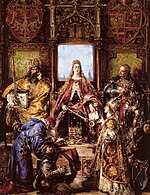
In the mid-14th century, King Casimir III the Great realised that the nation needed a class of educated people, especially lawyers, who could codify the country's laws and administer the courts and offices. His efforts to found an institution of higher learning in Poland were rewarded when Pope Urban V granted him permission to set up a university in Kraków. A royal charter of foundation was issued on 12 May 1364, and a simultaneous document was issued by the City Council granting privileges to the Studium Generale. The King provided funding for one chair in liberal arts, two in Medicine, three in Canon Law and five in Roman Law, funded by a quarterly payment taken from the proceeds of the royal monopoly on the salt mines at Wieliczka.[6]
Development of the University of Kraków stalled upon the death of King Casimir, its founder, and lectures were held in various places across the city, including, amongst others, in professors' houses, churches and in the cathedral school on the Wawel Hill. It is believed that, in all likelihood, the construction of a building to house the Studium Generale began on Plac Wolnica in what is today the district of Kazimierz.
After a period of disinterest and lack of funds, the institution was restored in the 1390s by King Władysław II Jagiełło and his wife Saint Hedwig, the daughter of King Louis of Hungary and Poland. The royal couple decided that, instead of building new premises for the university, it would be better to buy an existing edifice; it was thus that a building on Żydowska Street, which had previously been the property of the Pęcherz family, was found and acquired in 1399. The Queen donated all of her personal jewelry to the university, allowing it to enroll 203 students. The faculties of astronomy, law and theology attracted eminent scholars: for example, John Cantius, Stanisław of Skarbimierz, Paweł Włodkowic, Jan of Głogów, and Albert Brudzewski, who from 1491 to 1495 was one of Nicolaus Copernicus' teachers. The university was the first university in Europe to establish independent chairs in Mathematics and Astronomy. This rapid expansion in the university's faculty necessitated the purchase of larger premises in which to house them; it was thus that the building known today as the Collegium Maius, with its quadrangle and beautiful arcade, came into being towards the beginning of the 15th century. The Collegium Maius' qualities, many of which directly contributed to the sheltered, academic atmosphere at the university, became widely respected, helping the university establish its reputation as a place of learning in Central Europe.
Golden age of the Renaissance

For several centuries, virtually the entire intellectual elite of Poland were educated at the university,[7] where they enjoyed particular royal favour, often being provided with game from the royal hunt to satisfy their needs at mealtime. Whilst it was, and largely remains, Polish students who make up the greater part of the university's student body, it has, over its long history, educated thousands of foreign students from countries such as Lithuania, Russia, Hungary, Bohemia, Germany, and Spain. During the second half of the 15th century, over 40 percent of students came from outside the Kingdom of Poland.

The first chancellor of the University was Piotr Wysz, and the first professors were Czechs, Germans and Poles, many of them trained at the Charles University in Prague in Bohemia. By 1520 Greek philology was introduced by Constanzo Claretti and Wenzel von Hirschberg; Hebrew was also taught. At this time, the Collegium Maius comprised seven reading rooms, six of which were named for the great ancient scholars: Aristotle, Socrates, Plato, Galen, Ptolemy, and Pythagoras. Furthermore, it was during this period that the faculties of Law, Medicine, Theology, and Philosophy were established in their own premises; two of these buildings, the Collegium Iuridicum and Collegium Minus, survive to this day. The golden era of the University of Kraków took place during the Polish Renaissance, between 1500 and 1535, when it was attended by 3,215 students in the first decade of the 16th century, and it was in these early years that the foundations for the Jagiellonian Library were set, with the addition of a library floor to the Collegium Maius. The library's original rooms, in which all books were chained to their cases in order to prevent theft, are no longer used as such. However, they are still occasionally opened to host visiting lecturers' talks.
As the university's popularity, along with that of the ever more provincial Kraków's, declined in later centuries, the number of students attending the university also fell and, as such, the attendance record set in the early 16th century was not again surpassed until the late 18th century. This phenomenon was recorded as part of a more general economic and political decline seen in the Polish–Lithuanian Commonwealth, which was suffering from the effects of poor governance and the policies of hostile neighbors at the time. In fact, despite a number of expansion projects during the late 18th century, many of the university's buildings had fallen into disrepair and were being used for a range of other purposes; in the university's archives there is one entry which reads: 'Nobody lives in the building, nothing happens there. If the lecture halls underwent refurbishment they could be rented out to accommodate a laundry'. This period thus represents one of the darkest periods in the university's history and is almost certainly the one during which the closure of the institution seemed most imminent.
Decline and near closure after the partitions
This section needs additional citations for verification. (May 2017) |

After the third partition of Poland in 1795 and the ensuing Napoleonic Wars, Kraków became a free city under the protection of the Austrian Empire; this, however, was not to last long. In 1846, after the Kraków Uprising, the city and its university became part of the Austrian Empire.[8] The Austrians were in many ways hostile to the institution and, soon after their arrival, removed many of the furnishings from the Collegium Maius' Auditorium Maximum in order to convert it into a grain store. However, the threat of closure of the University was ultimately dissipated by Kaiser Ferdinand I of Austria's decree to maintain it. By the 1870s the fortunes of the university had improved so greatly that many scholars had returned. The liquefaction of nitrogen and oxygen was successfully demonstrated by professors Zygmunt Wróblewski and Karol Olszewski in 1883. Thereafter the Austrian authorities took on a new role in the development of the university and provided funds for the construction of a number of new buildings, including the neo-gothic Collegium Novum, which opened in 1887.[8] It was, conversely, from this building that in 1918 a large painting of Kaiser Franz Joseph was removed and destroyed by Polish students advocating the reestablishment of an independent Polish state.


For the 500th anniversary of the university's foundation, a monument to Copernicus was placed in the quadrangle of the Collegium Maius; this statue is now to be found in the direct vicinity of the Collegium Novum, outside the Collegium Witkowskiego, to where it was moved in 1953. Nevertheless, it was in the Grzegórzecka and the Kopernika areas that much of the university’s expansion took place up to 1918; during this time the Collegium Medicum was relocated to a site just east of the centre, and was expanded with the addition of a number of modern teaching hospitals – this 'medical campus' remains to this day. By the late 1930s the number of students at the university had increased dramatically to almost six thousand. Now a major centre for education in the independent Republic of Poland, the university attained government support for the purchase of building plots for new premises, as a result of which a number of residencies were built for students and professors alike. However, of all the projects begun during this era, the most important would have to be the creation of the Jagiellonian Library. The library's monumental building, construction of which began in 1931, was finally completed towards the end of the interwar period, which allowed the university's many varied literary collections to be relocated to their new home by the outbreak of war in 1939.
Modern era
On November 6, 1939, following the Nazi invasion of Poland, 184 professors were arrested and deported to Sachsenhausen concentration camp during an operation codenamed Sonderaktion Krakau (Special Operation Krakow). The university, along with the rest of Poland's higher and secondary education, was closed for the remainder of World War II.[9] Despite the university's reopening after the cessation of hostilities in 1945, the new government of Poland was hostile to the teachings of the pre-war university and the faculty was suppressed by the Communists in 1954.[9] By 1957 the Polish government decided that it would invest in the establishment of new facilities near Jordan Park and expansion of other smaller existing facilities. Sadly, as was typical for the period, construction work proved slow and many of the stated goals were never achieved; it was this poor management and disregard for the university's future that eventually led a number of scholars to openly criticise the government for its apparent lack of interest in educational development. On the other hand, a number of new buildings, such as the Collegium Biologicum, were built with funds from the legacy of Ignacy Paderewski.
By 1991 Poland had thrown off its Communist government and in that same year the Jagiellonian University successfully completed the purchase of its first building plot in Pychowice, Kraków, where, from 2000, construction of a new complex of university buildings, the so-called Third Campus, began; its completion is currently planned for 2015. The new campus, officially named the '600th Anniversary Campus', is being developed hand in hand with the new LifeScience Park, which is managed by the Jagiellonian Centre for Innovation, the university's research consortium.[10] Public funds earmarked for the project amounted to 946.5 million zlotys, or 240 million euros.[11] Poland's entry into the European Union in 2004 has proved instrumental in improving the fortunes of the Jagiellonian University, which has seen huge increases in funding from both central government and European authorities, allowing it to develop new departments, research centres, and better support the work of its students and academics.
International partnerships
The Jagiellonian University maintains an academic partnership with Heidelberg University, Germany's oldest university.[12] In particular, there are close ties between both Heidelberg's and Kraków's law schools. In conjunction with Heidelberg and Johannes Gutenberg University of Mainz, the Jagiellonian University offers specializations in German law.[13]
In the English-speaking world, the Jagiellonian University has international partnerships, among others, with the University of Cambridge, the University of Melbourne, the University of Chicago, and the University of California, Los Angeles. In the French-speaking world, partners include the Sorbonne, and the University of Montpellier. Other cooperation agreements exist with Charles University Prague, the University of Vienna, the University of Tokyo, Saint Petersburg State University, the Technical University of Munich, and the Free University of Berlin.[14][15]
Libraries


The university's main library, the Jagiellonian Library (Biblioteka Jagiellońska), is one of Poland's largest, with almost 6.5 million volumes; it is a constituent of the Polish National Libraries system.[16] It is home to a world-renowned collection of medieval manuscripts,[17] which includes Copernicus' De Revolutionibus and the Balthasar Behem Codex. The library also has an extensive collection of underground political literature (so-called drugi obieg or samizdat) from Poland's period of Communist rule between 1945 and 1989.
The beginning of the Jagiellonian Library is traditionally considered the same as that of the entire university – in 1364;[18] however, instead of having one central library it had several smaller branches at buildings of various departments (the largest collection was in Collegium Maius, where works related to theology and liberal arts were kept). After 1775, during the reforms of Komisja Edukacji Narodowej, which established the first Ministry of Education in the world, various small libraries of the University were formally centralised into one public collection in Collegium Maius. During the partitions of Poland, the library continued to grow thanks to the support of such people as Karol Józef Teofil Estreicher and Karol Estreicher. Its collections were made public in 1812. Since 1932, it has been recognised as a legal deposit library, comparable to the Bodleian Library at the University of Oxford or Cambridge University Library or Trinity College Library in Dublin, and thus has the right to receive a copy of any book issued by Polish publishers within Poland. In 1940, the library finally obtained a new building of its own, which has subsequently been expanded on two occasions, most recently in 1995–2001. During the Second World War, library workers cooperated with underground universities. Since the 1990s, the library's collection has become increasingly digitised.
In addition to the Jagiellonian Library, the university maintains a large medical library (Biblioteka Medyczna) and many other subject specialised libraries in its various faculties and institutes. Finally, the collections of the university libraries' collections are enriched by the presence of the university's archives, which date back to the university's own foundation and record the entire history of its development up to the present day.
Notable alumni
This article's list of alumni may not follow Wikipedia's verifiability policy. (May 2017) |


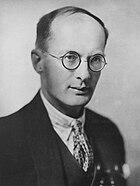


- Saint John Cantius 1390–1473; scholastic, theologian
- Jan Długosz 1415–1480; historian and chronicler
- Albert Brudzewski 1445–c.1497; astronomer, mathematician, philosopher and diplomat
- Stanisław Kazimierczyk also known as Saint Stanislaus of Kazimierz, C.R.L. 1433–1489; theologian
- Laurentius Corvinus 1465–1527; humanist; lecturer at the University
- Nicolaus Copernicus 1473–1543; astronomer; promoter of heliocentrism
- Maciej Miechowita 1457–1523; Ranaissance scholar, historian, chronicler, geographer, medical doctor, alchemist and astrologer
- Francysk Skaryna 1485?–1540?; pioneer of the Belarusian language; first to print a book in an Eastern Slavic language (1517 in Prague)
- Andrzej Frycz Modrzewski 1503?–1572; diplomat; political thinker; religious thinker
- Marcin Kromer 1512–1589; historian; Prince-Bishop of Warmia
- Jan Kochanowski 1530–1584; Polish Renaissance poet
- Cyprian Bazylik 1535-1600; composer; musician; poet
- Bartosz Paprocki c. 1543 – 1614; writer; historiographer; translator; poet; genealogist
- Stanisław Koniecpolski 1590?–1646; military commander; military politician; Grand Hetman of the Crown
- John III Sobieski 1629–1696; military leader; monarch of Polish–Lithuanian Commonwealth; victor of the Battle of Vienna
- Kasper Niesiecki 1682–1744; heraldist, lexicographer and theologian
- Wincenty Pol 1807–1872; poet; geographer
- Ignacy Łukasiewicz 1822–1882; pharmacist; deviser of the first method of distilling kerosene from seep oil
- Carl Menger 1840–1921; economist; lawyer; founder of the Austrian School of economics
- Karol Olszewski 1846–1915; physicist; chemist; the first to liquefy oxygen, nitrogen and carbon dioxide from the atmosphere
- Bohdan Lepky 1872–1941; Ukrainian writer and poet
- Wacław Sierpiński 1882–1969; mathematician
- Bronisław Malinowski 1884–1942; anthropologist
- Oskar Halecki 1891–1973; historian, social and Catholic activist
- Ivo Andric 1892–1975; Yugoslav novelist and poet, Nobel Prize laureate
- Adam Obrubański 1892–1940; reporter, manager of the Polish National Team, murdered by the Soviets in the Katyn Massacre
- Henryk Sławik 1894–1944; diplomat; recognised as Righteous Among the Nations for the rescue of Jews in World War II Hungary
- Yaroslav Halan, 1902–1949; Ukrainian anti-fascist playwright and publicist
- Prof Iwo Lominski 1905–1968; bacteriologist
- Leo Sternbach 1908–2005; chemist; inventor of the benzodiazepine
- Tadeusz Pankiewicz 1908–1993; pharmacist; Righteous Among the Nations who aided Jews in the Kraków Ghetto
- Józef Cyrankiewicz 1911–1989; Communist politician; Prime Minister of Poland 1947–1952, 1954–1970
- George Zarnecki 1915–2008; art historian specializing in English Romanesque art
- Antoni Kępiński 1918–1972; psychiatrist
- Saint Karol Wojtyła 1920–2005; later John Paul II, Pope of the Catholic Church
- Zbigniew Czajkowski b. 1921; fencer ("Father of the Polish School of fencing")
- Manuela Gretkowska, born 1964; writer, feminist and politician
- Stanisław Lem 1921–2006; science-fiction writer
- Wisława Szymborska 1923–2012; poet, 1996 Nobel laureate in Literature
- Yoram Gross 1926–2015; Australian animation producer
- Norman Davies b. 1939; British historian
- Krzysztof Zanussi b. 1939; film director
- Paulo Szot born 1969; Brazilian opera singer; winner of Tony Award for best actor on Broadway 2008
- Leopold Infeld 1898–1968; physicist
- Bat-Erdeniin Batbayar born c. 1954; politician, political analyst and writer.
- Kazimierz Papée 1889–1979; Polish Ambassador to the Holy See 1939–1958
- Volodymyr Kubiyovych (1900–1985), Ukrainian geographer, cartographer, encyclopedist, politician, and statesman.
- Andrzej Łobaczewski 1921–2007; psychologist who studied totalitarianism and introduced the concept of political ponerology
- Stanisław Łojasiewicz 1926–2002; mathematician
- Czeslaw Olech 1931–2015; mathematician
- Krzysztof Penderecki born 1933; composer and conductor
- Dr Artur Jurand FRSE 1914–2000; geneticist
- Poldek Pfefferberg 1913–2001; business owner who inspired Schindler's Ark, and its film adaptation, Schindler's List[19]
- Mietek Pemper 1920–2011; law student, Holocaust survivor who compiled Schindler's list
- Artur Ekert born 1961; physicist, one of the inventors of quantum cryptography
- Jerzy Tabeau 1918-2002 cardiologist one of the few escapees from Auschwitz concentration camp
- Jerzy Vetulani 1936-2017; neuroscientist, pharmacologist and biochemist
- Wojciech Inglot 1955–2013; chemist; founder of Inglot Cosmetics
- Beata Szydło born 1963; politician, former Prime Minister of Poland
- Maria Olech born 1941; Antarctic researcher; namesake of the Olech Hills in the Three Sisters point area of Antarctica
- Czeslaw Walek b. 1975; Czech lawyer and LGBT activist, studied law at the university 1993–99[20]
- Andrzej Duda b. 1972; lawyer, politician, the sixth and current President of Poland
Faculties and departments
| Academic rankings | |
|---|---|
| Global | |
| ARWU[21] | 301–400 |
| QS[22] | 431–440 |
| THE[23] | 601–800 |
The university is divided into 15 faculties which have different organisational sub-structures which partly reflect their history and partly their operational needs. Teaching and research at UJ is organised by faculties, which may include a number of other institutions:
- Law and Administration
- Medicine
- Pharmacy and Medical Analysis
- Health Care
- Philosophy
- History
- Philology
- Polish Language and Literature
- Physics, Astronomy and Applied Computer Science
- Mathematics and Computer Science
- Chemistry
- Biology and Earth Sciences
- Management and Social Communication
- International and Political Studies
- Biochemistry, Biophysics and Biotechnology
- University Center of Veterinary Medicine (joint faculty with Agricultural University of Krakow)
- National Center of Syncrotron Radiation SOLARIS (off-departmental facility)
Notable professors
- Stanisław of Skarbimierz (1360–1431), rector, theologian, lawyer
- Paweł Włodkowic (1370–1435), lawyer, diplomat and politician, representative of Poland on the Council of Constance
- Albert Brudzewski (1445–1497), astronomer and mathematician
- Maciej Miechowita (1457–1523), historian, chronicler, geographer, medic
- Marcin Szlachciński (1511/1512–?), scholar, translator, poet and philosopher
- Jan Brożek (1585–1652), mathematician, physician and astronomer
- Henryk Jordan (1842–1907), professor of obstetrics
- Walery Jaworski (1849–1924), gastroenterologist
- Ludwik Rydygier (1850–1920), general surgeon
- Albert Wojciech Adamkiewicz (1850–1921), pathologist, discovered the Artery of Adamkiewicz and the Adamkiewicz reaction
- Napoleon Cybulski (1854-1919), pioneer in endocrinology
- Edmund Załęski (1863–1932), agrotechnician and chemist
- Władysław Natanson (1864–1937), physicist
- Stanisław Estreicher (1869–1939), founder of the Jagiellonian University Museum
- Tadeusz Estreicher (1871–1952), pioneer in cryogenics
- Marian Smoluchowski (1872–1917), pioneer of statistical physics
- Bohdan Lepky (1872–1941), literature
- Stanisław Kutrzeba (1876–1946), rector, General Secretary of the Polish Academy of Learning
- Andrzej Gawroński (1885–1927), founder of the Polish Oriental Society, master of Sanskrit
- Stanisław Kot (1885–1975), historian and politician
- Jan Zawidzki (1886–1928), chemist and historian
- Tadeusz Sulimirski (1898–1983), historian and archaeologist, experts on the ancient Sarmatians
- Roman Grodecki (1889–1964) economic historian
- Stanisław Smreczyński (1899–1975) zoologist.
- Henryk Niewodniczański (1900–1968), physicist
- Adam Vetulani (1901–1976), historian of medieval law, canonist
- Franciszek Bujak (1909-1918 and again in 1946-1952), historian
- Wisława Szymborska (1923–2012), poet, recipient of the 1996 Nobel Prize in Literature
- Ryszard Gryglewski (born 1932), pharmacologist and physician, a discoverer of prostacyclin
- Andrzej Szczeklik (1932–2012), physician
- Jan Woleński (born 1940), philosopher
- Piotr Sztompka (born 1944), sociologist
- Jan Potempa (born 1955), biologist, recipient of the 2011 Prize of the Foundation for Polish Science[24]
- Krzysztof Kościelniak (born 1965), historian
Enrollment
As of 2008, the university has 52,445 students (including 1,612 degree students from abroad) and 3,657 academic staff. About 1,130 international non-degree students were enrolled in 2007. Programmes of study are offered in 48 disciplines and 93 specialisations.[25] The university has an exchange programme with The Catholic University of America and its Columbus School of Law.[26] It also hosts a "semester-abroad" programme with the University of Wisconsin-Stevens Point and the University of Guelph.
Student associations
In 1851, the university's first student scientific association was founded. Now, over 70 student scientific associations exist at the Jagiellonian University. Usually, their purpose is to promote students' scientific achievements by organizing lecture sessions, science excursions, and international student conferences, such as the International Workshop for Young Mathematicians, which is organized by the Zaremba Association of Mathematicians.
The links below provide further information on student activities at the Jagiellonian:
-
Collegium Novum
-
Collegium Maius, the oldest building of the university
-
Collegium Broscianum on Grodzka Street
-
Collegium Physicum
-
Larysz Palace, Faculty of Law and Administration
-
Faculty of Physics, Astronomy and Applied Computer Science
-
Theatrum Anatomicum of the Faculty of Medicine
-
Przegorzały Castle, the seat of the Institute of European Studies
-
Campus of the 600th Anniversary of University's Revival
-
Auditorium Maximum with theatre stage seating 1,200
See also
- List of medieval universities
- Nawojka, the university's legendary first female student from the 15th century
- Sonderaktion Krakau, a Nazi German operation against professors and academics from the University of Kraków
- Neuronus IBRO & IRUN Neuroscience Forum
Notes and references
- ^ a b "Jagiellonian University Facts and Figures 2017". en.uj.edu.pl. Jagiellonian University. 2015. Retrieved 3 July 2017.
- ^ "Overview – UJ". www.en.uj.edu.pl. Retrieved 2017-01-04.
- ^ "Study in Poland". Top Universities. 2014-09-03. Retrieved 2017-01-04.
- ^ "Jagiellonian University". Times Higher Education (THE). Retrieved 2017-01-04.
- ^ "Academic Ranking of World Universities 2019". Retrieved 2018-12-07.
- ^ Davies, Norman (1982). God's Playground; A History of Poland, Vol. I: The Origins to 1795. Columbia University Press. p. 98. ISBN 978-0-231-05351-8.
- ^ source needed
- ^ a b Waltos, Stanisław. "History". Jagiellonian University. Retrieved 2010-09-28. Template:Pl icon
- ^ a b Weigel, George (2001). Witness of Hope – The Biography of Pope John Paul II. HarperCollins. ISBN 978-0-06-018793-4.
- ^ "Campus of the Sixcentenary". Retrieved 2011-05-12.
- ^ "Campus of the Sixcentenary". Retrieved 2010-09-28.
- ^ Watzke, Christian. "Partneruniversitäten – International – Universität Heidelberg". www.uni-heidelberg.de. Retrieved 2017-01-04.
- ^ "Schule des Deutschen Rechts —". www.law.uj.edu.pl. Retrieved 2017-01-04.
- ^ "Archived copy". Archived from the original on 2017-01-05. Retrieved 2017-01-05.
{{cite web}}: CS1 maint: archived copy as title (link) - ^ "O Dziale – Dział Współpracy Międzynarodowej Uniwersytetu Jagiellońskiego". Dwm.uj.edu.pl. Retrieved 2017-04-30.
- ^ Bętkowska, Teresa (18 May 2008). "Jagiellonian University: Cracow's Alma Mater". Warsaw Voice. Archived from the original on 13 June 2011. Retrieved 2010-09-28.
- ^ "BJ: Medieval manuscripts". Bj.uj.edu.pl. Archived from the original on 2011-05-14. Retrieved 2010-09-28.
- ^ Visiting the Biblioteka Jagiellonska (Jagiellonian Library) in Cracow Archived 2005-09-08 at the Wayback Machine. Last accessed on 4 May 2007.
- ^ Gebler, Carlo. "Finding Oskar". The Irish Times. Retrieved 2018-12-10.
- ^ Borufka, Sarah (29 August 2011). "Czeslaw Walek – Prague Pride's first director and a lawyer by profession". Radio Praha. Retrieved 8 May 2017.
- ^ "2024 Academic Ranking of World Universities". ShanghaiRanking Consultancy. August 15, 2024. Retrieved August 21, 2024.
- ^ "QS World University Rankings 2025". Quacquarelli Symonds. June 4, 2024. Retrieved August 9, 2024.
- ^ "World University Rankings 2024". Times Higher Education. September 27, 2023. Retrieved August 9, 2024.
- ^ "Department of Oral Health & Rehabilitation — School of Dentistry". Louisville.edu. Retrieved 2017-04-30.
- ^ Newsletter, web: UJ-News35-PDF Archived 2008-10-31 at the Wayback Machine.
- ^ "Annual Summer Law Program". The Catholic University of America. Retrieved 2010-09-28.



